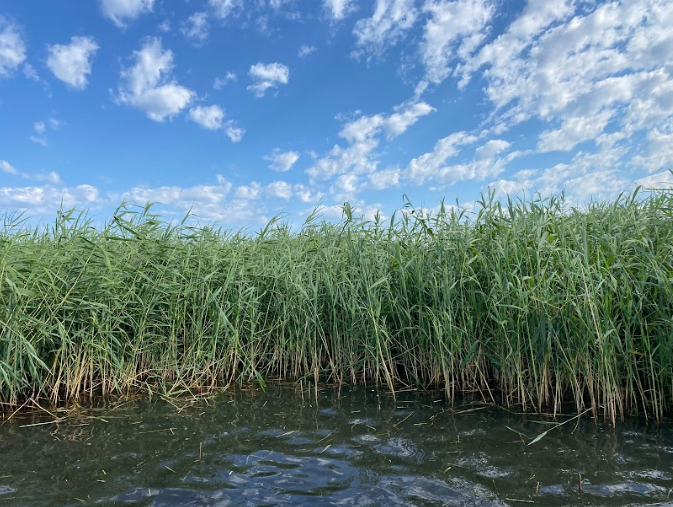
About Phragmites
Phragmites australis
Invasive Phragmites australis (referred to as Phragmites) is a perennial wetland grass. Phragmites is also known as common reed or European common reed.
Phragmites can form into dense monoculture stands which outcompete native plants for light, water, and nutrients. They can exceed 5 meters in height in favourable growing conditions, often making it significantly taller than other non-tree species in the area. Phragmites is often found in roadside ditches throughout Ontario.
Phragmites is considered Ontario’s worst invasive plant due to its wide distribution in the province and its variety of impacts on the environment and infrastructure.
Phragmites Identification
Invasive Phragmites can grow very tall, often reaching heights of over 15 feet (4.5 meters). This makes it significantly taller than many other plants in wetland areas. The stems of invasive Phragmites are thick and sturdy, often forming dense stands. During the growing season, the stem can be tan or brown with blue-green leaves which grow alternately. Invasive Phragmites produce large seed heads which appear “feathery”, transitioning from tan or purple-brown to a cream colour as they mature. Phragmites thrives in wetland habitats, including marshes, swamps, riverbanks, and coastal areas; however, Phragmites is also capable of growing in upland environments if growing conditions are favourable.
History of Invasive Phragmites
Phragmites is native to many areas in Asia and Europe and has been historically used for thatch roofing, basket weaving, weaving mats, and other crafts. The exact history of its introduction varies by location, but human activities such as shipping, trade, and agriculture likely played a role in its spread beyond its native range. It was likely introduced to North America unintentionally through soil ballast and intentionally through the horticultural trade on the Atlantic coast.
Impacts of Invasive Phragmites
Reduction in Biodiversity – Invasive Phragmites forms dense monocultures which outcompete and displace native plants. This reduction in plant diversity results in reduced habitat quality for wildlife, including birds, reptiles, fish, mammals, and insects that depend on diverse wetland vegetation for food and shelter.
Loss of Habitat - Native wildlife species that rely on wetland habitats for nesting, foraging, and breeding may be negatively impacted by invasive Phragmites. The dense stands of this plant can limit access to open water and reduce available space for native plants that support diverse wildlife.
Alteration of Wetland Structure and Function – The dense growth of invasive Phragmites alters wetland hydrology by impeding water flow and increasing sediment deposition. This can lead to changes in water depth, nutrient cycling, and oxygen levels, affecting the overall health and function of the wetland ecosystem.
Fire Risk – Phragmites stands are made up of a high percentage of dried stalks which accumulate over time. These stalks are highly flammable, increasing the risk and intensity of fires. This can present a significant risk to infrastructure as invasive Phragmites often grow in areas adjacent to construction.
Socioeconomic Impacts – Invasive Phragmites clogging agricultural drains and growing fields can result in economic loss for farmers and its necessary management to reduce its impact introduces additional financial burdens. The presence of Phragmites lowers the value and enjoyment of properties, particularly properties with high recreational value such as cottages. Phragmites tall and dense growth can limit access to shoreline and impact other recreational activities such as boating, fishing, hunting, and swimming.
Phragmites Spread and Reproduction
Phragmites spreads through seed production and the expansion of its root system, called rhizomes. A single seed head of Phragmites can produce 2000 seeds a year. In dense colonies of Phragmites, there can be as many as 200 stems per square meter, resulting in tens of thousands of seeds produced per square meter. These seeds can remain dormant in soil for up to three years and the movement of soil contaminated with Phragmites seeds has contributed to Ontario’s Phragmites crisis. Phragmites rhizomes are underground stems which connect to the parent plant. These rhizomes produce roots and additional stems adjacent to the parent plant which allow Phragmites to quickly dominate their ecosystem. Phragmites’ rhizome fragments, pieces of the rhizome which have broken away from the parent plant due to weather or human intervention, are capable of establishing a colony if relocated to a site with suitable growing conditions. Phragmites has spread throughout Ontario because of the movement of soil contaminated with rhizome fragments and seeds, on offroad vehicles, in boat ballast water, and in construction equipment.








